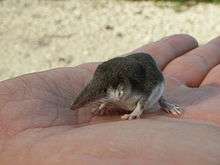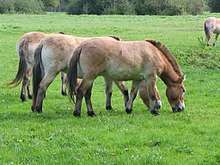List of mammals of Ukraine
There are eighty-five mammal species in Ukraine, of which two are critically endangered, two are endangered, thirteen are vulnerable, and three are near threatened. One of the species listed for Ukraine can no longer be found in the wild.[1] The following tags are used to highlight each species' conservation status as assessed by the International Union for Conservation of Nature:
| CR | Critically endangered | The species is in imminent risk of extinction in the wild. |
| EN | Endangered | The species is facing an extremely high risk of extinction in the wild. |
| VU | Vulnerable | The species is facing a high risk of extinction in the wild. |
| NT | Near threatened | The species does not meet any of the criteria that would categorise it as risking extinction but it is likely to do so in the future. |
| LC | Least concern | There are no current identifiable risks to the species. |
| DD | Data deficient | There is inadequate information to make an assessment of the risks to this species. |
| EX | Extinct | No reasonable doubt that the last individual has died. |
| EW | Extinct in the wild | Known only to survive in captivity or as a naturalized populations well outside its previous range. |
Order: Rodentia (rodents)
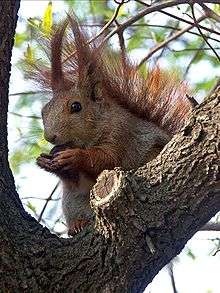
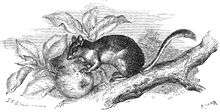
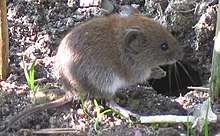
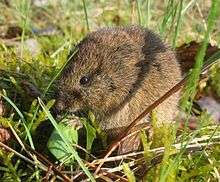


Rodents make up the largest order of mammals, with over 40% of mammalian species. They have two incisors in the upper and lower jaw which grow continually and must be kept short by gnawing.
- Suborder: Sciurognathi
- Family: Sciuridae (squirrels)
- Subfamily: Sciurinae
- Tribe: Sciurini
- Genus: Sciurus
- Red squirrel, S. vulgaris LC[2]
- Genus: Sciurus
- Tribe: Sciurini
- Subfamily: Sciurinae
- Family: Castoridae (beavers)
- Genus: Castor
- Eurasian beaver, C. fiber LC[3]
- Subfamily: Xerinae
- Tribe: Marmotini
- Genus: Marmota
- Bobak marmot, Marmota bobak LC
- Genus: Spermophilus
- European ground squirrel, Spermophilus citellus VU
- Little ground squirrel, Spermophilus pygmaeus LC
- Speckled ground squirrel, Spermophilus suslicus VU
- Genus: Marmota
- Tribe: Marmotini
- Genus: Castor
- Family: Gliridae (dormice)
- Subfamily: Leithiinae
- Genus: Dryomys
- Forest dormouse, Dryomys nitedula LC
- Genus: Eliomys
- Garden dormouse, Eliomys quercinus VU
- Genus: Muscardinus
- Hazel dormouse, Muscardinus avellanarius LC
- Genus: Dryomys
- Subfamily: Glirinae
- Genus: Glis
- Edible dormouse, Glis glis LC
- Genus: Glis
- Subfamily: Leithiinae
- Family: Dipodidae (jerboas)
- Subfamily: Dipodinae
- Genus: Stylodipus
- Thick-tailed three-toed jerboa, Stylodipus telum LC
- Genus: Stylodipus
- Subfamily: Sicistinae
- Genus: Sicista
- Northern birch mouse, Sicista betulina LC
- Southern birch mouse, Sicista subtilis LC
- Genus: Sicista
- Subfamily: Dipodinae
- Family: Spalacidae
- Subfamily: Spalacinae
- Genus: Spalax
- Sandy mole rat, Spalax arenarius VU
- Bukovin mole rat, Spalax graecus VU
- Greater mole rat, Spalax microphthalmus VU
- Podolsk mole rat, Spalax zemni LC
- Genus: Nannospalax
- Lesser mole rat, Nannospalax leucodon VU
- Genus: Spalax
- Subfamily: Spalacinae
- Family: Cricetidae
- Subfamily: Cricetinae
- Genus: Cricetulus
- Grey dwarf hamster, Cricetulus migratorius LC
- Genus: Cricetulus
- Subfamily: Arvicolinae
- Genus: Arvicola
- European water vole, A. amphibius LC[4]
- Genus: Chionomys
- Snow vole, Chionomys nivalis LC
- Genus: Arvicola
- Genus: Clethrionomys
- Bank vole, Clethrionomys glareolus LC
- Genus: Ellobius
- Northern mole vole, Ellobius talpinus LC
- Genus: Lagurus
- Steppe lemming, Lagurus lagurus LC
- Genus: Microtus
- Common vole, Microtus arvalis LC
- Tundra vole, Microtus oeconomus LC
- Southern vole, Microtus rossiaemeridionalis LC
- Social vole, Microtus socialis LC
- European pine vole, Microtus subterraneus LC
- Tatra vole, Microtus tatricus LC
- Subfamily: Cricetinae
- Family: Muridae (mice, rats, voles, gerbils, hamsters, etc.)
- Subfamily: Murinae
- Genus: Apodemus
- Striped field mouse, Apodemus agrarius LC
- Yellow-necked mouse, Apodemus flavicollis LC
- Yellow-breasted field mouse, Apodemus fulvipectus LC
- Wood mouse, Apodemus sylvaticus LC
- Ural field mouse, Apodemus uralensis LC
- Genus: Micromys
- Harvest mouse, Micromys minutus LC
- Genus: Mus
- Steppe mouse, Mus spicilegus LC
- Genus: Apodemus
- Subfamily: Murinae
- Family: Sciuridae (squirrels)
Order: Lagomorpha (lagomorphs)
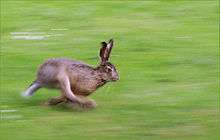
The lagomorphs comprise two families, Leporidae (hares and rabbits), and Ochotonidae (pikas). Though they can resemble rodents, and were classified as a superfamily in that order until the early 20th century, they have since been considered a separate order. They differ from rodents in a number of physical characteristics, such as having four incisors in the upper jaw rather than two.
- Family: Leporidae (rabbits, hares)
- Genus: Lepus
- European hare, L. europaeus LC[5]
- Mountain hare, L. timidus LC
- Genus: Lepus
Order: Erinaceomorpha (hedgehogs and gymnures)
The order Erinaceomorpha contains a single family, Erinaceidae, which comprise the hedgehogs and gymnures. The hedgehogs are easily recognised by their spines while gymnures look more like large rats.
- Family: Erinaceidae (hedgehogs)
- Subfamily: Erinaceinae
- Genus: Erinaceus
- Southern white-breasted hedgehog, E. concolor LC
Order: Soricomorpha (shrews, moles, and solenodons)
The "shrew-forms" are insectivorous mammals. The shrews and solenodons closely resemble mice while the moles are stout-bodied burrowers.
- Family: Soricidae (shrews)
- Subfamily: Crocidurinae
- Genus: Crocidura
- Bicolored shrew, Crocidura leucodon LC
- Lesser white-toothed shrew, Crocidura suaveolens LC
- Genus: Crocidura
- Subfamily: Soricinae
- Tribe: Nectogalini
- Genus: Neomys
- Southern water shrew, Neomys anomalus LC
- Genus: Neomys
- Tribe: Soricini
- Genus: Sorex
- Common shrew, Sorex araneus LC
- Laxmann's shrew, Sorex caecutiens LC
- Eurasian pygmy shrew, Sorex minutus LC
- Caucasian pygmy shrew, Sorex volnuchini LC
- Genus: Sorex
- Tribe: Nectogalini
- Subfamily: Crocidurinae
- Family: Talpidae (moles)
- Subfamily: Talpinae
- Tribe: Desmanini
- Genus: Desmana
- Russian desman, Desmana moschata VU
- Genus: Desmana
- Tribe: Desmanini
- Subfamily: Talpinae
Order: Chiroptera (bats)
The bats' most distinguishing feature is that their forelimbs are developed as wings, making them the only mammals capable of flight. Bat species account for about 20% of all mammals.
- Family: Vespertilionidae
- Subfamily: Myotinae
- Genus: Myotis
- Bechstein's bat, M. bechsteini NT[6]
- Pond bat, M. dasycneme NT[7]
- Greater mouse-eared bat, M. myotis LC[8]
- Geoffroy's bat, Myotis emarginatus LC
- Natterer's bat, Myotis nattereri LC
- Genus: Myotis
- Subfamily: Vespertilioninae
- Genus: Barbastella
- Barbastelle, Barbastella barbastellus VU
- Genus: Hypsugo
- Savi's pipistrelle, H. savii LC[9]
- Genus: Nyctalus
- Greater noctule bat, N. lasiopterus NT[10]
- Lesser noctule, N. leisleri LC[11]
- Genus: Pipistrellus
- Kuhl's pipistrelle, Pipistrellus kuhlii LC
- Genus: Plecotus
- Brown long-eared bat, Plecotus auritus LC
- Grey long-eared bat, Plecotus austriacus LC
- Genus: Barbastella
- Subfamily: Myotinae
- Family: Molossidae
- Genus: Tadarida
- European free-tailed bat, Tadarida teniotis LC
- Genus: Tadarida
- Family: Rhinolophidae
- Subfamily: Rhinolophinae
- Genus: Rhinolophus
- Greater horseshoe bat, Rhinolophus ferrumequinum LC
- Lesser horseshoe bat, Rhinolophus hipposideros LC
- Genus: Rhinolophus
- Subfamily: Rhinolophinae
Order: Cetacea (whales)
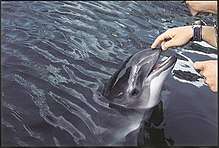
The order Cetacea includes whales, dolphins and porpoises. They are the mammals most fully adapted to aquatic life with a spindle-shaped nearly hairless body, protected by a thick layer of blubber, and forelimbs and tail modified to provide propulsion underwater.
- Suborder: Odontoceti
- Superfamily: Platanistoidea
- Family: Phocoenidae
- Genus: Phocoena
- Harbour porpoise, Phocoena phocoena VU
- Genus: Phocoena
- Family: Delphinidae (marine dolphins)
- Genus: Tursiops
- Bottlenose dolphin, Tursiops truncatus DD
- Genus: Delphinus
- Short-beaked common dolphin, Delphinus delphis LC
- Genus: Tursiops
- Family: Phocoenidae
- Superfamily: Platanistoidea
Order: Carnivora (carnivorans)
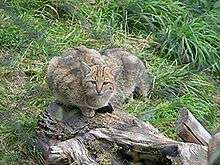
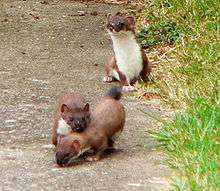
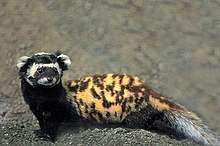
There are over 260 species of carnivorans, the majority of which feed primarily on meat. They have a characteristic skull shape and dentition.
- Suborder: Feliformia
- Family: Felidae (cats)
- Subfamily: Felinae
- Genus: Felis
- European wildcat, F. silvestris
- Genus: Felis
- Subfamily: Felinae
- Family: Felidae (cats)
- Suborder: Caniformia
- Family: Canidae (dogs, foxes)
- Family: Ursidae (bears)
- Genus: Ursus
- Brown bear, U. arctos LC[14]
- Eurasian brown bear, U. a. arctos
- Brown bear, U. arctos LC[14]
- Genus: Ursus
- Family: Mustelidae (mustelids)
- Genus: Mustela
- European mink, M. lutreola CR[15]
- Stoat, M. erminea LC[16]
- Least weasel, M. nivalis LC[17]
- European polecat, M. putorius LC[18]
- Steppe polecat, M. eversmannii LC
- Genus: Vormela
- Marbled polecat, V. peregusna VU[19]
- Genus: Martes
- Beech marten, M. foina LC[20]
- Genus: Meles
- Eurasian badger, M. meles LC[21]
- Genus: Lutra
- European otter, L. lutra NT[22]
- Genus: Mustela
- Family: Phocidae (earless seals)
- Genus: Monachus
- Mediterranean monk seal, M. monachus EN[23]
- Genus: Monachus
Order: Perissodactyla (odd-toed ungulates)
The odd-toed ungulates are browsing and grazing mammals. They are usually large to very large, and have relatively simple stomachs and a large middle toe.
- Family: Equidae (horses etc.)
- Genus: Equus
- Przewalski's horse, Equus ferus przewalskii EN[24][25]
- Turkmenian kulan, Equus hemionus kulan EN
- Genus: Equus
Order: Artiodactyla (even-toed ungulates)
The even-toed ungulates are ungulates whose weight is borne about equally by the third and fourth toes, rather than mostly or entirely by the third as in perissodactyls. There are about 220 artiodactyl species, including many that are of great economic importance to humans.
- Family: Bovidae (cattle, antelope, sheep, goats)
- Subfamily: Antilopinae
- Genus: Saiga
- Saiga antelope, S. tatarica CR[26]
- Genus: Saiga
- Subfamily: Bovinae
- Subfamily: Antilopinae
- Family: Suidae (pigs)
- Family: Cervidae (deer)
See also
References
- This list is derived from the IUCN Red List which lists species of mammals and includes those mammals that have recently been classified as extinct (since 1500 AD). The taxonomy and naming of the individual species is based on those used in existing Wikipedia articles as of 21 May 2007 and supplemented by the common names and taxonomy from the IUCN, Smithsonian Institution, or University of Michigan where no Wikipedia article was available.
- Amori, G.; Hutterer, R.; Kryštufek, B.; Yigit, N.; Mitsain, G. & Muñoz, L. J. P. (2010). "Sciurus vulgaris". IUCN Red List of Threatened Species. 2010: e.T20025A9136220.
- Batbold, J.; Batsaikhan, N.; Shar, S.; Hutterer, R.; Kryštufek, B.; Yigit, N.; Mitsain, G.; Palomo, L. (2016). "Castor fiber". IUCN Red List of Threatened Species. 2016: e.T4007A115067136.
- Batsaikhan, N.; Henttonen, H.; Meinig, H.; Shenbrot, G., Bukhnikashvili, A., Hutterer, R., Kryštufek, B., Yigit, N., Mitsain, G. & Palomo, L. (2016). "Arvicola amphibius". IUCN Red List of Threatened Species. 2016: e.T2149A115060819.CS1 maint: multiple names: authors list (link)
- Hacklande, K.; Schai-Braun, S. (2019). "Lepus europaeus". The IUCN Red List of Threatened Species. 2019: e.T41280A45187424.
- Paunović, M. (2019). "Myotis bechsteinii". IUCN Red List of Threatened Species. 2019: e.T14123A22053752.
- Piraccini, R. (2016). "Myotis dasycneme". IUCN Red List of Threatened Species. 2016: e.T14127A22055164.
- Coroiu, I.; Juste, J. & Paunović, M. (2016). "Myotis myotis". IUCN Red List of Threatened Species. 2016: e.T14133A22051759.CS1 maint: multiple names: authors list (link)
- Hutson, A. M.; Spitzenberger, F.; Juste, J.; Aulagnier, S.; Palmeirim, J.; Paunovic, M.; Karatas, A. (2010). "Hypsugo savii". IUCN Red List of Threatened Species. 2010: e.T44856A10955205.
- Hutson, A. M.; Alcaldé, J. T.; Juste, J.; Karataş, A.; Palmeirim, J. & Paunović, M. (2010). "Nyctalus lasiopterus". IUCN Red List of Threatened Species. 2010: e.T14918A4471682.CS1 maint: multiple names: authors list (link)
- Juste, J. & Paunović, M. (2016). "Nyctalus leisleri". IUCN Red List of Threatened Species. 2016: e.T14919A22016159.CS1 maint: multiple names: authors list (link)
- Boitani, L.; Phillips, M. & Jhala, Y. (2018). "Canis lupus". IUCN Red List of Threatened Species. 2018: e.T3746A119623865.
- Hoffmann, M. & Sillero-Zubiri, C. (2016). "Vulpes vulpes". IUCN Red List of Threatened Species. 2016: e.T23062A46190249.
- McLellan, B. N.; Proctor, M. F.; Huber, D. & Michel, S. (2017). "Ursus arctos". IUCN Red List of Threatened Species. 2017: e.T41688A121229971.
- Maran, T.; Aulagnier, S.; Libois, R.; Kranz, A.; Abramov, A. & Wozencraft, C. (2010). "Mustela lutreola". IUCN Red List of Threatened Species. 2010: e.T14018A4381596.
- Reid, F.; Helgen, K. & Kranz, A. (2016). "Mustela erminea". IUCN Red List of Threatened Species. 2016: e.T29674A45203335.
- McDonald, R. A.; Abramov, A. V.; Stubbe, M.; Herrero, J.; Maran, T.; Tikhonov, A.; Cavallini, P.; Kranz, A.; Giannatos, G.; Kryštufek, B. & Reid, F. (2019). "Mustela nivalis". IUCN Red List of Threatened Species. 2019: e.T70207409A147993366.
- Skumatov, D.; Abramov, A.V.; Herrero, J.; Kitchener, A.; Maran, T.; Kranz, A.; Sándor, A.; Stubbe, M.; Saveljev, A.; Savour-Soubelet, A.; Guinot-Ghestem, M.; Zuberogoitia, I.; Birks, J.D.S.; Weber, A.; Melisch, R. & Ruette, S. (2016). "Mustela putorius". IUCN Red List of Threatened Species. 2016: e.T41658A45214384.CS1 maint: multiple names: authors list (link)
- Abramov, A.V.; Kranz, A. & Maran, T. (2016). "Vormela peregusna". IUCN Red List of Threatened Species. 2016: e.T29680A45203971.
- Abramov, A.V.; Kranz, A.; Herrero, J.; Krantz, A.; Choudhury, A. & Maran, T. (2016). "Martes foina". IUCN Red List of Threatened Species. 2016: e.T29672A45202514.
- Kranz, A.; Abramov, A. V.; Herrero, J. & Maran, T. (2016). "Meles meles". IUCN Red List of Threatened Species. 2016: e.T29673A45203002.
- Roos, A.; Loy, A.; de Silva, P.; Hajkova, P. & Zemanová, B. (2015). "Lutra lutra". IUCN Red List of Threatened Species. 2015: e.T12419A21935287.
- Karamanlidis, A. & Dendrinos, P. (2015). "Monachus monachus". IUCN Red List of Threatened Species. 2015: e.T13653A45227543.
- "The Last Truly Wild Horses Are Alive and Well in Chernobyl". Popular Mechanics. October 17, 2019. Retrieved 16 February 2020.
- "Chernobyl shocker: Endangered wild horses move into Exclusion Zone". New York Post. October 30, 2019. Retrieved 16 February 2020.
- IUCN SSC Antelope Specialist Group (2018). "Saiga tatarica". IUCN Red List of Threatened Species. 2018: e.T19832A50194357.
- Lovari, S.; Herrero, J.; Masseti, M.; Ambarli, H.; Lorenzini, R. & Giannatos, G. (2016). "Capreolus capreolus". IUCN Red List of Threatened Species. 2016: e.T42395A22161386.CS1 maint: multiple names: authors list (link)
External links
- "Animal Diversity Web: Mammalia". University of Michigan Museum of Zoology. 1995–2014. Retrieved 21 March 2016.
